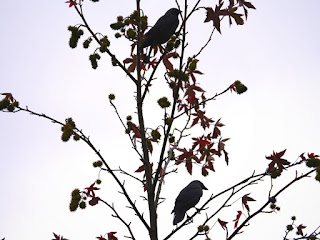A day of intermittent rain. A Grey Heron stood stoically on a dead willow near the Italian Garden.
One of the Peregrines huddled miserably on the barracks tower.
Feral Pigeons sheltered under the cornice of the bridge.
A Carrion Crow perched on a gas lamp ...
... and a pair of Jackdaws among the red leaves of a sweetgum tree.
Long-Tailed Tits continued their endless hunt for insects.
The affectionate pair of Black-Headed Gulls who constantly display to each other were in their usual place on the south shore of the Serpentine.
A Herring Gull stared down haughtily from an urn in the Italian Garden.
Another Black-Headed Gull showed no respect for the statue of Edward Jenner, the inventor of smallpox vaccination whose discovery led to the total eradication of the disease.
However, the statue, by William Calder Marshall, has seen worse things. It was originally in Trafalgar Square, where its installation in 1858 was furiously opposed by both anti-vaxers and the military, who complained that he was the only civilian in the square and, worse, was sitting down when all the generals and admirals were standing up. It was removed to the park in 1862. The British Medical Journal commented that the other statues remained in Trafalgar Square 'because they killed their fellow creatures whereas he only saved them'.
Honourable mention should be made of one of these military men in the square, Charles James Napier who, as Commander-in-Chief of British forces in India, saved far more lives than he took by prohibiting the practice of suttee, burning widows alive on the funeral pyre of their husbands. When Hindu priests protested, he is said to have replied, 'Be it so. This burning of widows is your custom; prepare the funeral pile. But my nation has also a custom. When men burn women alive we hang them, and confiscate all their property. My carpenters shall therefore erect gibbets on which to hang all concerned when the widow is consumed. Let us all act according to national customs.'
A Great Crested Grebe on the Long Water was already in its plain winter plumage.
While I was taking this picture from the bridge, another pair of grebes shot under it and flew up the Long Water.
A Cormorant on the other side of the bridge tried to dry its wings in the drizzle.
In wet weather, when there are few people and their dogs in the park, the Canada and Greylag Geese can move on to the lush grass on the north side of the Serpentine. There was a brief glimpse of one of the Bar-Headed x Greylag hybrids which often fly in from St James's Park.
A Shoveller drake had shovelled up enough tiny water creatures to satisfy him, and attended to his fine feathers.












Thanks for the interesting piece of history: I knew about suttee, but not about Napier.
ReplyDeleteThere's another statue of Napier in Queen's Gate (the street) just outside Queen's Gate (the gate).
DeleteLet us all salute Charles James Napier. They don't make the likes of him any longer, sadly. English quiet forcefulness at its best.
ReplyDeleteI wish Grebes flew for their admirers' benefit more often. It is always a miracle of engineering, flying on those tiny wings.
I would be haughty if I were a gull, too. They do everything well, and only their small weak feet stand between them and world domination.
No sight of the Black Swan today?
Grebes remind me of the F-104 Starfighter. Their stalling speed is uncomfortably high. Takeoff requires a long desperate run, and descent is a semi-controlled crash.
DeleteI didn't see the Black Swan, but on dark days it's easy to lose it in a crowd of Mute Swans.